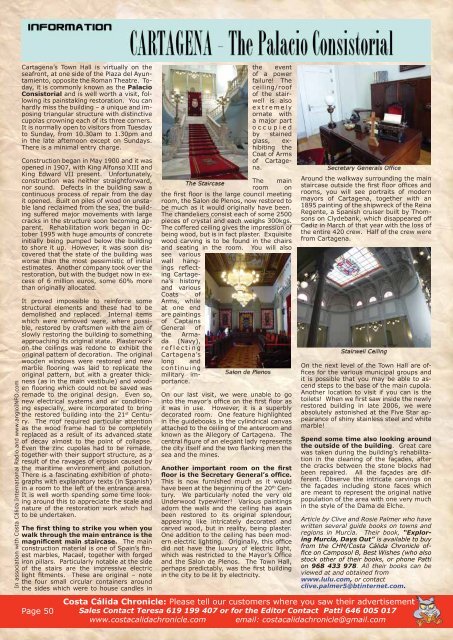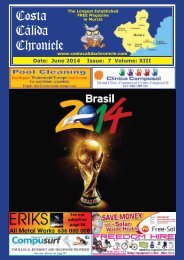august-2014
august-2014
august-2014
Create successful ePaper yourself
Turn your PDF publications into a flip-book with our unique Google optimized e-Paper software.
In association with Costa Cálida International Radio and www.angloINFO.com<br />
Cartagena’s Town Hall is virtually on the<br />
seafront, at one side of the Plaza del Ayuntamiento,<br />
opposite the Roman Theatre. Today,<br />
it is commonly known as the Palacio<br />
Consistorial and is well worth a visit, following<br />
its painstaking restoration. You can<br />
hardly miss the building – a unique and imposing<br />
triangular structure with distinctive<br />
cupolas crowning each of its three corners.<br />
It is normally open to visitors from Tuesday<br />
to Sunday, from 10.30am to 1.30pm and<br />
in the late afternoon except on Sundays.<br />
There is a minimal entry charge.<br />
Construction began in May 1900 and it was<br />
opened in 1907, with King Alfonso XIII and<br />
King Edward VII present. Unfortunately,<br />
construction was neither straightforward,<br />
nor sound. Defects in the building saw a<br />
continuous process of repair from the day<br />
it opened. Built on piles of wood on unstable<br />
land reclaimed from the sea, the building<br />
suffered major movements with large<br />
cracks in the structure soon becoming apparent.<br />
Rehabilitation work began in October<br />
1995 with huge amounts of concrete<br />
initially being pumped below the building<br />
to shore it up. However, it was soon discovered<br />
that the state of the building was<br />
worse than the most pessimistic of initial<br />
estimates. Another company took over the<br />
restoration, but with the budget now in excess<br />
of 6 million euros, some 60% more<br />
than originally allocated.<br />
It proved impossible to reinforce some<br />
structural elements and these had to be<br />
demolished and replaced. Internal items<br />
which were removed were, where possible,<br />
restored by craftsmen with the aim of<br />
slowly restoring the building to something<br />
approaching its original state. Plasterwork<br />
on the ceilings was redone to exhibit the<br />
original pattern of decoration. The original<br />
wooden windows were restored and new<br />
marble flooring was laid to replicate the<br />
original pattern, but with a greater thickness<br />
(as in the main vestibule) and wooden<br />
flooring which could not be saved was<br />
remade to the original design. Even so,<br />
new electrical systems and air conditioning<br />
especially, were incorporated to bring<br />
the restored building into the 21 st Century.<br />
The roof required particular attention<br />
as the wood frame had to be completely<br />
replaced as a result of its advanced state<br />
of decay almost to the point of collapse.<br />
Even the zinc cupolas had to be remade,<br />
together with their support structure, as a<br />
result of the ravages of erosion caused by<br />
the maritime environment and pollution.<br />
There is a fascinating exhibition of photographs<br />
with explanatory texts (in Spanish)<br />
in a room to the left of the entrance area.<br />
It is well worth spending some time looking<br />
around this to appreciate the scale and<br />
nature of the restoration work which had<br />
to be undertaken.<br />
The first thing to strike you when you<br />
walk through the main entrance is the<br />
magnificent main staircase. The main<br />
construction material is one of Spain’s finest<br />
marbles, Macael, together with forged<br />
iron pillars. Particularly notable at the side<br />
of the stairs are the impressive electric<br />
light fitments. These are original – note<br />
the four small circular containers around<br />
the sides which were to house candles in<br />
Page 50<br />
the event<br />
of a power<br />
failure! The<br />
ceiling/roof<br />
of the stairwell<br />
is also<br />
extremely<br />
ornate with<br />
a major part<br />
occupied<br />
by stained<br />
glass, exhibiting<br />
the<br />
Coat of Arms<br />
of Cartagena.<br />
The main<br />
room on<br />
the first floor is the large council meeting<br />
room, the Salon de Plenos, now restored to<br />
be much as it would originally have been.<br />
The chandeliers consist each of some 2500<br />
pieces of crystal and each weighs 300kgs.<br />
The coffered ceiling gives the impression of<br />
being wood, but is in fact plaster. Exquisite<br />
wood carving is to be found in the chairs<br />
and seating in the room. You will also<br />
see various<br />
wall hangings<br />
reflecting<br />
Cartagena’s<br />
history<br />
and various<br />
Coats of<br />
Arms, while<br />
at one end<br />
are paintings<br />
of Captains<br />
General of<br />
the Armada<br />
(Navy),<br />
reflecting<br />
Cartagena’s<br />
long and<br />
continuing<br />
military importance.<br />
On our last visit, we were unable to go<br />
into the mayor’s office on the first floor as<br />
it was in use. However, it is a superbly<br />
decorated room. One feature highlighted<br />
in the guidebooks is the cylindrical canvas<br />
attached to the ceiling of the anteroom and<br />
known as the Allegory of Cartagena. The<br />
central figure of an elegant lady represents<br />
the city itself and the two flanking men the<br />
sea and the mines.<br />
Another important room on the first<br />
floor is the Secretary General’s office.<br />
This is now furnished much as it would<br />
have been at the beginning of the 20 th Century.<br />
We particularly noted the very old<br />
Underwood typewriter! Various paintings<br />
adorn the walls and the ceiling has again<br />
been restored to its original splendour,<br />
appearing like intricately decorated and<br />
carved wood, but in reality, being plaster.<br />
One addition to the ceiling has been modern<br />
electric lighting. Originally, this office<br />
did not have the luxury of electric light,<br />
which was restricted to the Mayor’s Office<br />
and the Salon de Plenos. The Town Hall,<br />
perhaps predictably, was the first building<br />
in the city to be lit by electricity.<br />
Around the walkway surrounding the main<br />
staircase outside the first floor offices and<br />
rooms, you will see portraits of modern<br />
mayors of Cartagena, together with an<br />
1895 painting of the shipwreck of the Reina<br />
Regente, a Spanish cruiser built by Thomsons<br />
on Clydebank, which disappeared off<br />
Cadiz in March of that year with the loss of<br />
the entire 420 crew. Half of the crew were<br />
from Cartagena.<br />
On the next level of the Town Hall are offices<br />
for the various municipal groups and<br />
it is possible that you may be able to ascend<br />
steps to the base of the main cupola.<br />
Another location to visit if you can is the<br />
toilets! When we first saw inside the newly<br />
restored building in late 2006, we were<br />
absolutely astonished at the Five Star appearance<br />
of shiny stainless steel and white<br />
marble!<br />
Spend some time also looking around<br />
the outside of the building. Great care<br />
was taken during the building’s rehabilitation<br />
in the cleaning of the façades, after<br />
the cracks between the stone blocks had<br />
been repaired. All the façades are different.<br />
Observe the intricate carvings on<br />
the façades including stone faces which<br />
are meant to represent the original native<br />
population of the area with one very much<br />
in the style of the Dama de Elche.<br />
Article by Clive and Rosie Palmer who have<br />
written several guide books on towns and<br />
regions in Murcia. Their book, “Exploring<br />
Murcia, Days Out” is available to buy<br />
from the CHM/Costa Cálida Chronicle office<br />
on Camposol B, Best Wishes (who also<br />
stock other of their books, or phone Patti<br />
on 968 433 978. All their books can be<br />
viewed at and obtained from<br />
www.lulu.com, or contact<br />
clive.palmer5@btinternet.com.<br />
Costa Cálida Chronicle: Please tell our customers where you saw their advertisement t<br />
Sales Contact Teresa 619 199 407 or for the Editor Contact Patti 646 005 017<br />
www.costacalidachronicle.com email: costacalidachronicle@gmail.com



